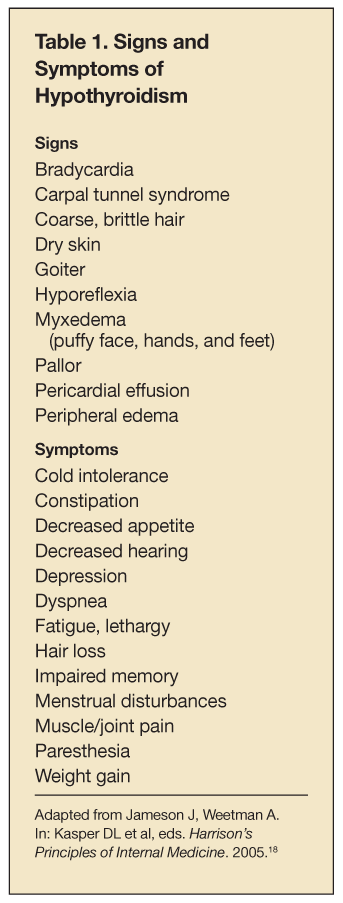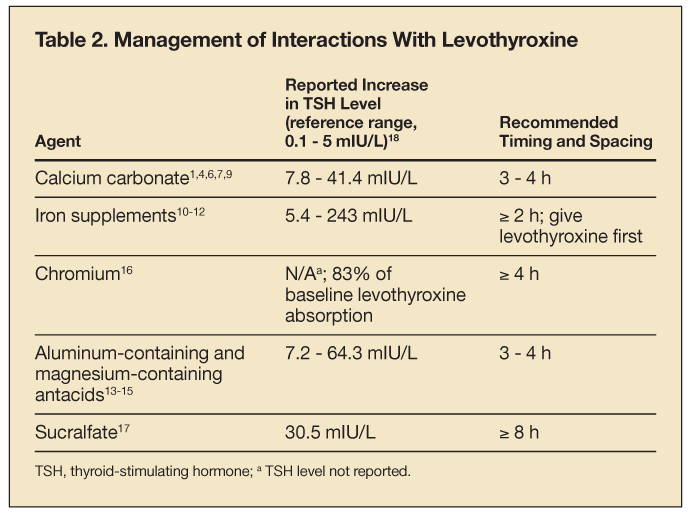Managing Drug Interactions That Can Reduce Levothyroxine Efficacy
Levothyroxine is one of the most commonly prescribed medications for the treatment of persons with hypothyroidism and the suppression of thyroid neoplasms.1 Most persons with hypothyroidism require lifelong therapy with levothyroxine.
Key words: Drug interactions, Levothyroxine, Hypothyroidism
Levothyroxine is one of the most commonly prescribed medications for the treatment of persons with hypothyroidism and the suppression of thyroid neoplasms.1 Most persons with hypothyroidism require lifelong therapy with levothyroxine.
The absorption of levothyroxine after oral administration is about 80%.1 Certain drugs and dietary components2,3 can interfere with the bioavailability of levothyroxine. Drugs include calcium carbonate,4-9 iron salts,10-12 and aluminum13-15 and magnesium-containing15 antacids.

Drug InteractionsCalcium carbonate. Schneyer4 first reported in 1998 that calcium carbonate reduced the efficacy of levothyroxine and proposed that calcium carbonate, excipients, or contaminants in the preparation may form insoluble chelates with levothyroxine, resulting in decreased absorption. A cohort study of 20 patients who were receiving long-term levothyroxine therapy and calcium carbonate showed reduced levothyroxine absorption and significant increases in thyroid-stimulating hormone (TSH) levels.1 In vitro data collected by the same investigators revealed that levothyroxine adsorbs to calcium carbonate at a pH of 2.0, which simulates a gastric pH.
In a pharmacokinetic study of 7 healthy volunteers, Singh and colleagues5 demonstrated that coadministration of calcium carbonate with levothyroxine reduces total thyroxine absorption over 6 hours. Four case reports have confirmed the significance of this interaction.6-9
Ferrous salts and chromium. Campbell and colleagues10 first studied the interaction of levothyroxine and ferrous sulfate in 1992. For 12 weeks, ferrous sulfate was added daily to the regimen of 14 patients who were receiving stable levothyroxine replacement therapy. Eleven patients had an increase in TSH levels; 9 patients experienced an increase in signs and symptoms of hypothyroidism. In vitro data verified the formation of insoluble complexes of the iron molecule with levothyroxine.10
A case report of a pregnant woman showed the clinical relevance of the interaction of ferrous sulfate and levothyroxine. The patient developed hypothyroidism with the addition of ferrous sulfate, necessitating an increase in the levothyroxine dose; she developed hyperthyroidism when the iron supplement was discontinued.11 Another case report also showed an increase in TSH levels in a patient who took daily ferrous fumarate supplements.12Chromium is similar to iron in molecular size and charge. It is available OTC as a dietary supplement and is most often used for glucose control and weight loss. In a pharmacokinetic study of 7 healthy volunteers, chromium decreased levothyroxine absorption.16
Aluminum- and magnesium-containing antacids. An increase in TSH levels with aluminum hydroxide was first reported in 1992 in a euthyroid patient (patient with a normally functioning thyroid) who was taking a stable dose of levothyroxine. The patient’s TSH level returned to baseline after the aluminum hydroxide–containing antacid was discontinued; it increased again with rechallenge.13 The investigators confirmed this observation in 5 additional patients and in in vitro experiments that showed complexing of levothyroxine to aluminum hydroxide.14 (Note that sucralfate is a complex of aluminum hydroxide and can interfere with levothyroxine absorption.17)
Another case series confirmed the aluminum interaction by in vitro experiments and resulted in decreased absorption with magnesium oxide. In vitro experiments with various magnesium salts showed that magnesium carbonate may be more likely than magnesium oxide to adsorb to levothyroxine.15

Management of Interactions
Frequent screening for drug interactions is prudent in persons who are receiving levothyroxine therapy. Consider the possibility of a drug interaction when patients present with worsening signs and symptoms of hypothyroidism (Table 1). A thorough medication history should include questions about use of OTC medications, such as antacids and laxatives, and dietary supplements, in order to identify divalent and trivalent cations. These products may be used by patients to treat symptoms of hypothyroidism, such as constipation. In addition, many postmenopausal women receive levothyroxine therapy; therefore, concurrent use of calcium supplements is likely.
Management of these interactions can be resolved by discontinuing the interacting drug or supplement; if this is not possible, advise patients to separate the doses of the 2 agents (Table 2). For patients who are receiving long-term supplementation with iron or calcium, more frequent monitoring or adjustment of the levothyroxine dose may be required.
References:
References
1. Singh N, Singh PN, Hershman JM. Effect of calcium carbonate on the absorption of levothyroxine. JAMA. 2000;283:2822-2825.
2. Liel Y, Harman-Boehm I, Shany S. Evidence for a clinically important adverse effect of fiberenriched diet on the bioavailability of levothyroxine in adult hypothyroid patients. J Clin Endocrinol Metab. 1996;81:857-859.
3. Benvenga S, Bartolone L, Squadrito S, et al. Delayed intestinal absorption of levothyroxine. Thyroid. 1995;5:249-253.
4. Schneyer CR. Calcium carbonate and reduction of levothyroxine efficacy. JAMA. 1998;279:750.
5. Singh N, Weisler SL, Hershman JM. The acute effect of calcium carbonate on the intestinal absorption of levothyroxine. Thyroid. 2001;11:967-971.
6. Butner LE, Fulco PP, Feldman G. Calcium carbonate-induced hypothyroidism. Ann Intern Med. 2000;132:595.
7. Csako G, McGriff NJ, Rotman-Pikielny P, et al. Exaggerated levothyroxine malabsorption due to calcium carbonate supplementation in gastrointestinal disorders. Ann Pharmacother. 2001; 35:1578-1583.
8. Mazokopakis EE. Counseling patients receiving levothyroxine (L-T4) and calcium carbonate. Mil Med. 2006;171:vii, 1094.
9. Mazokopakis EE, Giannakopoulos TG, Starakis IK. Interaction between levothyroxine and calcium carbonate. Can Fam Physician. 2008;54:39.
10. Campbell NR, Hasinoff BB, Stalts H, et al. Ferrous sulfate reduces thyroxine efficacy in patients with hypothyroidism. Ann Intern Med. 1992;117:1010-1013.
11. Shakir KM, Chute JP, Aprill BS, Lazarus AA. Ferrous sulfate-induced increase in requirement for thyroxine in a patient with primary hypothyroidism. South Med J. 1997;90:637-639.
12. Leger C, Ooi T. Ferrous fumarate-induced malabsorption of thyroxine. Endocrinologist. 1999;9: 493-496.
13. Sperber AD, Liel Y. Evidence for interference with the intestinal absorption of levothyroxine sodium by aluminum hydroxide. Arch Intern Med. 1992;152:183-184.
14. Liel Y, Sperber AD, Shany S. Nonspecific intestinal adsorption of levothyroxine by aluminum hydroxide. Am J Med. 1994;97:363-365.
15. Mersebach H, Rasmussen AK, Kirkegaard L, Feldt-Rasmussen U. Intestinal adsorption of levothyroxine by antacids and laxatives: case stories and in vitro experiments. Pharmacol Toxicol. 1999;84:107-109.
16. John-Kalarickal J, Pearlman G, Carlson HE. New medications which decrease levothyroxine absorption. Thyroid. 2007;17:763-765.
17. Sherman SI, Tielens ET, Ladenson PW. Sucralfate causes malabsorption of l-thyroxine. Am J Med. 1994;96:531-535.
18. Jameson J, Weetman A. Disorders of the thyroid gland. In: Kasper DL, Braunwald E, Fauci AS, Hauser SL, eds. Harrison’s Principles of Internal Medicine. 16th ed. New York: McGraw-Hill; 2005: 2104-2127.